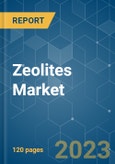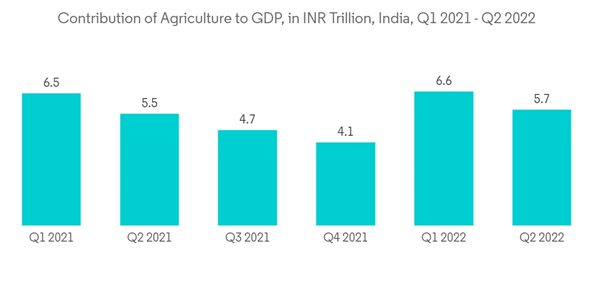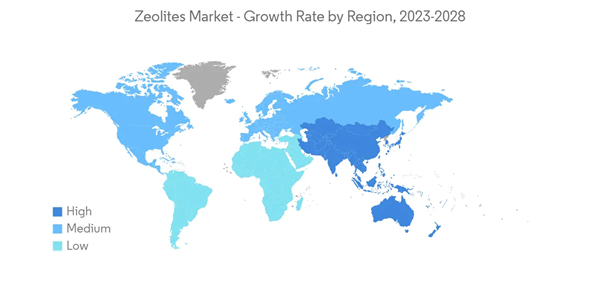The COVID-19 pandemic significantly impacted the manufacturing operations of zeolites and their raw materials. Global zeolite production witnessed a decline during the first half of 2021. It is due to the raw materials, labor shortage, and government-mandated plant shutdowns. However, the market is recovering after the pandemic with the growing demand in the water treatment industry.
Key Highlights
- The major factors driving the market studied are increasing demand from the water treatment industry and increasing zeolite use as refrigeration adsorbents.
- The usage of zeolite substitutes is expected to hinder the market's growth.
- Moreover, the increasing demand for compact detergents will likely act as an opportunity for the market studied in the forecast period.
- Asia-Pacific dominated the global market, with the largest consumption from countries such as China and India.
Zeolites Market Trends
Agriculture Industry to Dominate the Market
- Due to their high ion exchange and water retention capacity, natural zeolites are extensively used in fertilizers and soil amendment procedures. Zeolites are also used to increase the ammonia retentively of the soil.
- In the fertilizer industry, zeolites trap undesirable metals and prevent the intake of heavy metals in the food chain. Zeolites trap metals like copper, cadmium, lead, and zinc. Due to their high ion exchange capacity, zeolites are seen as effective carriers of herbicides, fungicides, and pesticides.
- The North American agriculture sector is growing steadily, owing to the decrease in the demand for fertilizer and the drop in grain prices in the domestic and global markets. The margin for growers declined, which, in turn, reduced the economic potential of farmers to buy fertilizers for crops.
- The United States is a major player in the global trade of agricultural products. In 2021, exports of agricultural products were worth some USD 172 billion. In 2021, the net value added of the United States agricultural sector amounted to approximately USD 190 billion. Agriculture, food, and related industries contributed roughly USD 1.26 trillion to the United States' gross domestic product (GDP) in 2021, a 5.4% share.
- In Europe, there is an increase in biofuel and bioenergy consumption, increasing the demand for fodder crops. As fodder crops are the largest consumers of fertilizers, they are expected to boost the zeolite demand.
- In Asia-Pacific, the agricultural sector is expected to grow for various reasons. Along with meat and dairy, urban consumers eat more freshly produced and processed fruits, vegetables, juices, etc. Therefore, freshly produced food items will continue to grow as the population shifts from rural areas to cities. In India, agriculture is one of the largest sectors and contributes significantly to the country's GDP.
- During the second quarter of 2022, the contribution of India's agriculture sector to the country's GDP was valued at over INR 5.7 trillion (~USD 77 billion). Additionally, in FY2022, the export value of agriculture and allied products was over USD 50 billion from India. The agricultural export value was over USD 41 billion during FY2021.
- The growth above in the global agriculture industry is likely to contribute to the demand for zeolites during the forecast period.
China to Dominate the Market in the Asia-Pacific Region
- China dominated the Asia-Pacific region's market share. Though the growth in the country remains high, it is gradually diminishing as the population ages, and the economy is rebalancing from investment to consumption, manufacturing to services, and external to internal demand.
- China became the largest construction market in the world. In 2021, the construction industry value in China amounted to USD 1,117 billion. As the government planned to focus on improving the infrastructure in small and medium-sized cities, the construction industry was forecast to grow continuously at around 5% annually. Thus it is anticipated to increase the usage of zeolites in construction applications.
- China's most recent environmental report remains negative, suggesting that 61.5% of groundwater and 28.8% of key rivers were classed as 'unsuitable for human contact.' China requires high-grade wastewater treatment technologies to reverse the severe water pollution, thereby increasing the demand for zeolites in the country.
- In 2015, China released its Water Action Plan, which requires 90% of cities to improve their sludge treatment capacity by the end of 2023. Experts estimate that between 2021 and 2025, China will invest around USD 8 billion to construct and install new sludge processing facilities. China plans to build or renovate 80,000 km of sewage collection pipeline networks and increase sewage treatment capacity by 20 million cubic meters/day between 2021-2025.
- Similarly, China accounts for approximately 7% of the overall agricultural acreage globally, thus feeding 22% of the world population. The country is the largest producer of various crops, including rice, cotton, potatoes, and many other vegetables. Thus it is expected to boost the zeolite market during the forecast period.
- Moreover, many refineries in the country have planned to increase their capacities over the next few years to meet the increasing demand for various chemicals and petrochemicals. With the growing demand for various chemicals globally, the demand for zeolites from this sector is projected to grow during the forecast period.
- In 2021, China's refinery output hit a record up 4.3% from 2020 due to strong fuel demand in the first half of the year and refiners ramping up processing to bridge a supply shortfall after a sizable new tax closed loopholes in blending fuel imports. According to the National Bureau of Statistics, total refinery throughput reached 703.55 million tons or 14.07 million barrels per day (bpd) in 2021.
- Thus, the factors above are expected to boost the consumption of zeolites in various industries.
Zeolites Industry Overview
The zeolites market is consolidated in nature. The major companies include BASF SE, Honeywell International Inc., Clariant, Tosoh Corporation, and Arkema Group (not in any particular order).Additional Benefits:
- The market estimate (ME) sheet in Excel format
- 3 months of analyst support
This product will be delivered within 2 business days.
Table of Contents
1 INTRODUCTION1.1 Study Assumptions
1.2 Scope of the Study
2 RESEARCH METHODOLOGY
3 EXECUTIVE SUMMARY
4 MARKET DYNAMICS
4.1 Drivers
4.1.1 Increasing Demand from Water Treatment Industry
4.1.2 Increasing Use of Zeolite as Refrigeration Adsorbents
4.1.3 Significant Usage of Zeolites for Catalytic Cracking in the Petroleum Industry
4.2 Restraints
4.2.1 Usage of Substitutes for Zeolites
4.3 Industry Value Chain Analysis
4.4 Porter's Five Forces Analysis
4.4.1 Bargaining Power of Suppliers
4.4.2 Bargaining Power of Consumers
4.4.3 Threat of New Entrants
4.4.4 Threat of Substitute Products and Services
4.4.5 Degree of Competition
5 MARKET SEGMENTATION (Market Size in Value)
5.1 Product Type
5.1.1 Natural
5.1.2 Synthetic
5.2 Application
5.2.1 Adsorbents
5.2.2 Catalysts
5.2.3 Detergents
5.2.4 Other Applications (Refining, Biogas)
5.3 End-user Industry
5.3.1 Water Treatment
5.3.2 Air Purification
5.3.3 Agriculture
5.3.4 Petrochemical
5.3.5 Construction
5.3.6 Other End-user Industries (Medical, Nuclear Industry)
5.4 Geography
5.4.1 Asia-Pacific
5.4.1.1 China
5.4.1.2 India
5.4.1.3 Japan
5.4.1.4 South Korea
5.4.1.5 Rest of Asia-Pacific
5.4.2 North America
5.4.2.1 United States
5.4.2.2 Canada
5.4.2.3 Mexico
5.4.3 Europe
5.4.3.1 Germany
5.4.3.2 United Kingdom
5.4.3.3 Italy
5.4.3.4 France
5.4.3.5 Rest of Europe
5.4.4 South America
5.4.4.1 Brazil
5.4.4.2 Argentina
5.4.4.3 Rest of South America
5.4.5 Middle East & Africa
5.4.5.1 Saudi Arabia
5.4.5.2 South Africa
5.4.5.3 Rest of Middle East & Africa
6 COMPETITIVE LANDSCAPE
6.1 Mergers and Acquisitions, Joint Ventures, Collaborations, and Agreements
6.2 Market Share Analysis**/Ranking Analysis
6.3 Strategies Adopted by Leading Players
6.4 Company Profiles
6.4.1 Arkema Group
6.4.2 BASF SE
6.4.3 Clariant
6.4.4 Honeywell International Inc.
6.4.5 International Zeolite Corp.
6.4.6 Interra Global
6.4.7 KNT Group
6.4.8 SHOWA DENKO KK
6.4.9 Tosoh Corporation
6.4.10 W. R. Grace & Co.
6.4.11 ZEOCEM AS
6.4.12 Zeolyst International Inc.
6.4.13 Zeomex
7 MARKET OPPORTUNITIES AND FUTURE TRENDS
7.1 Increasing Demand for Compact Detergents
Companies Mentioned (Partial List)
A selection of companies mentioned in this report includes, but is not limited to:
- Arkema Group
- BASF SE
- Clariant
- Honeywell International Inc.
- International Zeolite Corp.
- Interra Global
- KNT Group
- SHOWA DENKO KK
- Tosoh Corporation
- W. R. Grace & Co.
- ZEOCEM AS
- Zeolyst International Inc.
- Zeomex










